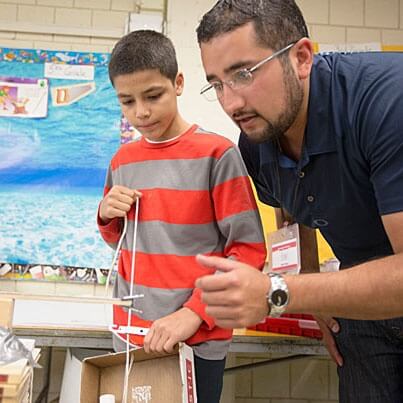News
SEAS research and education specialist Jorge Pozo works on a presentation with Juan Nazario at the Hennigan Elementary School in Jamaica Plain. (Photo by Kris Snibbe, Harvard Staff Photographer.)
Eleven-year-old Juan Nazario had a problem. He had to create a device that moved a potato six feet while using the least amount of force possible.
To make matters worse, Vikki Irving-Kent, the “owner” of the mythical potato chip factory for which Nazario worked, hovered nearby and kept tabs on his progress. Fortunately, Nazario had Jorge Pozo and Anindita Basu, scientists from Harvard’s School of Engineering and Applied Sciences (SEAS), on hand to help.
Nazario and Irving-Kent, who in real life is Nazario’s science teacher, were playing out an engineering scenario to help fifth graders learn basic engineering concepts involving simple machines.
To move his potato, Nazario used a wheel and axle, an inclined plane, and a pulley, trying out four designs over the last six weeks. On Saturday, he and about 60 other fifth graders who have designed similar machines will be at Harvard with their parents to demonstrate what they’ve learned and what they’ve built.
Pozo, a research and education specialist with the school, and Basu, a postdoctoral fellow in the lab of David Weitz, Mallinckrodt Professor of Physics and Applied Physics, are among seven volunteers who have been helping as part of a SEAS outreach program to the Hennigan Elementary School in Jamaica Plain. The program is part of a broader outreach effort led by Kathryn Hollar, director of educational programs for SEAS, that brings Harvard science to local public schools to nurture students’ natural desires to invent and to ignite their interest in scientific discovery.
“We’re here trying to get students to learn more by doing with their hands,” Pozo said. “By us showing them, they know what a simple machine is, they know what an inclined plane is, a pulley …”
Read the entire article in the Harvard Gazette
Cutting-edge science delivered direct to your inbox.
Join the Harvard SEAS mailing list.
